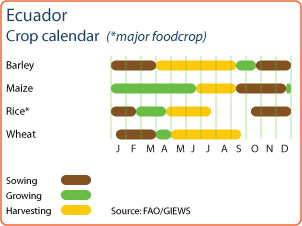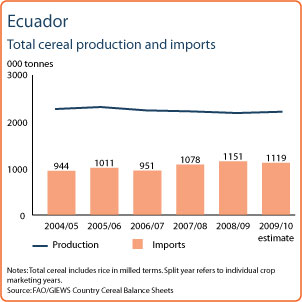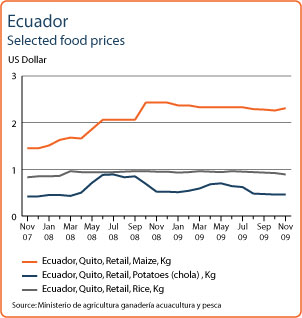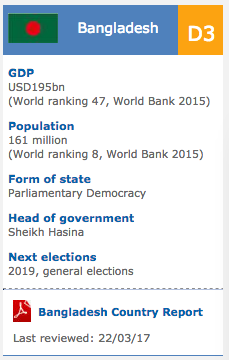Ecuador: Ecuador Agriculture Profile 2012
2012/03/08
Ecuador Agriculture Profile 2012
Reference Date: 10-June-2011
|
FOOD SECURITY SNAPSHOT
|
Drought affects 2011 cereal production prospects
Harvesting of 2011 winter maize and rice crops is in progress. Early 2011 rice estimates point to a production of 1.4 million tonnes, 12 percent less than last year. Similarly, maize production estimates show a decrease compared to the low level of last year. The decrease in the 2011 cereal production prospects is due to the reduction in the area sown and a decrease in yield which resulted from the lack of rain from February to April and above average temperatures in coastal areas, particularly in the production province of Guayas. At the beginning of April, the government declared a state of emergency in six of the country's 24 provinces: Loja, Los Ríos, Guayas, Santa Elena, Manabí and El Oro. Rainfall in May arrived too late to avoid crop losses. Official estimates indicate that around 180 000 hectares of rice and maize crops were lost during the period of water shortage. The government has assigned USD 46 million to tackle the state of emergency and allow for supplementary irrigation. In 2011, an increase is forecast for maize imports while rice stocks should guarantee a sufficient supply despite losses.
On 1 June, the government set the minimum price support at Ecuador Sucre 16.5 (USD 0.00064) per quintal (45.36 kg) for 2011 winter maize.
Reference Date: 06-April-2010
|
FOOD SECURITY SNAPSHOT
|
Heavy rains end prolonged dry weather conditions
Driven by government measures, planting the 2010 wheat crop is approaching completion
Increased domestic demand for wheat in 2009/10
03/12/2010 Heavy rains end prolonged dry weather conditions
 Prolonged drought conditions affected the country in the last months of 2009, in particular the province of Manabí where important staple crops such as maize and beans have reported some localized losses.
Prolonged drought conditions affected the country in the last months of 2009, in particular the province of Manabí where important staple crops such as maize and beans have reported some localized losses.Then, in February, heavy showers caused floods and landslides. The most affected provinces were Esmeraldas, Manabí, El Oro, Guayas and Los Ríos, where almost 70 percent of the total annual maize production is concentrated.
Harvesting of 2010 winter maize, mainly yellow is scheduled to start in May. Despite localized damages to newly born plants caused by the reported flooding, planted area, approximately 430 000 hectares, is very similar to previous year.
 In northern and central highlands, planting of 2010 main wheat crop is almost complete and sowed area is similar to the average level of the last five years. However, government incentive programs, including the distribution of improved seeds and subsidies for the purchase of agricultural inputs, are expected to boost average yields and increase production.
In northern and central highlands, planting of 2010 main wheat crop is almost complete and sowed area is similar to the average level of the last five years. However, government incentive programs, including the distribution of improved seeds and subsidies for the purchase of agricultural inputs, are expected to boost average yields and increase production.Similarly, planting of the first 2010 rice crop, which represents almost 75 percent of total production, is recently completed in coastal provinces. The area planted is reported at 330 000 hectares, a level similar to the average of the last three years.
 Cereal import requirements for marketing year 2009/10 (July/June) are forecast to slightly increase compared to the level of 2008/09, mainly due to the high domestic demand of wheat and wheat products, favoured by more stable international prices, and wider dissemination of school feeding programmes.
Cereal import requirements for marketing year 2009/10 (July/June) are forecast to slightly increase compared to the level of 2008/09, mainly due to the high domestic demand of wheat and wheat products, favoured by more stable international prices, and wider dissemination of school feeding programmes.Forestry, and Fishing
- Related Articles
-
东帝汶农业概况
2012/08/27 更多
-
- Ecuador News
-
- ISRAEL: Netanyahu’s Historic Latin American Tour to Highlight Israeli Tech Sector
- ISRAEL: PM Netanyahu leaves on historic visit to Latin America
- AFGHANISTAN: UNWTO: International tourism – strongest half-year results since 2010
- AFGHANISTAN: Higher earning Why a university degree is worth more in some countries than others
- ARGENTINA: China looks to deepen ties with Latin America
- ECUADOR: Guayaquil real estate Big construction projects to substantially improve quality of life
- Trending Articles
-
- SOUTH AFRICA: Nigeria and South Africa emerge from recession
- UZBEKISTAN: Former deputy PM named Uzbekistan Airways head
- AUSTRALIA: Western Australia joins two-thirds of country to ban fracking
- BAHRAIN: Bahrain issues new rules to encourage fintech growth
- BAHRAIN: Aluminium Bahrain’s Line 6 Expansion Achieves 25 Percent Completion
- CHINA: Chinese-supported infrastructure projects change Zambia's landscape








